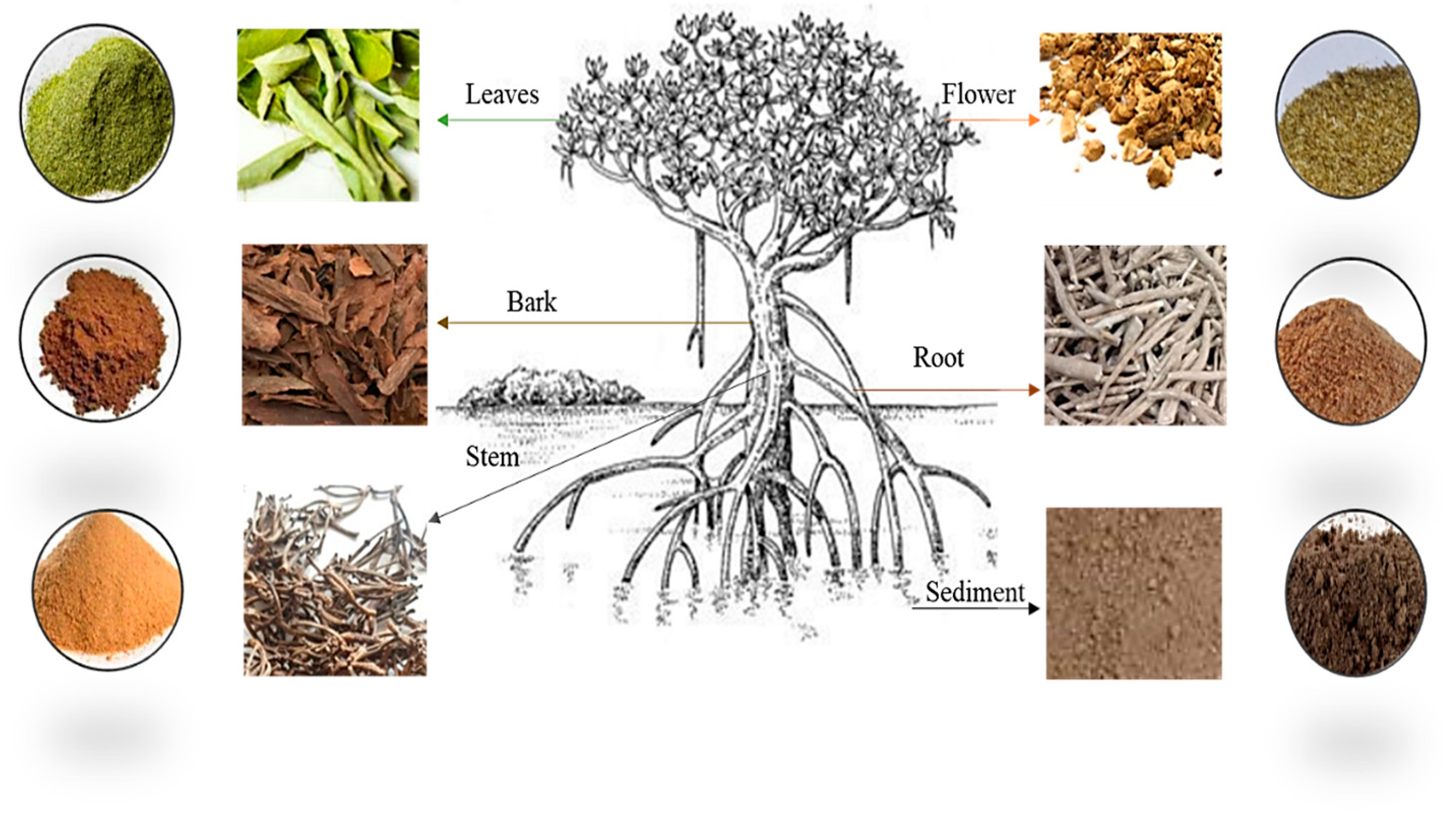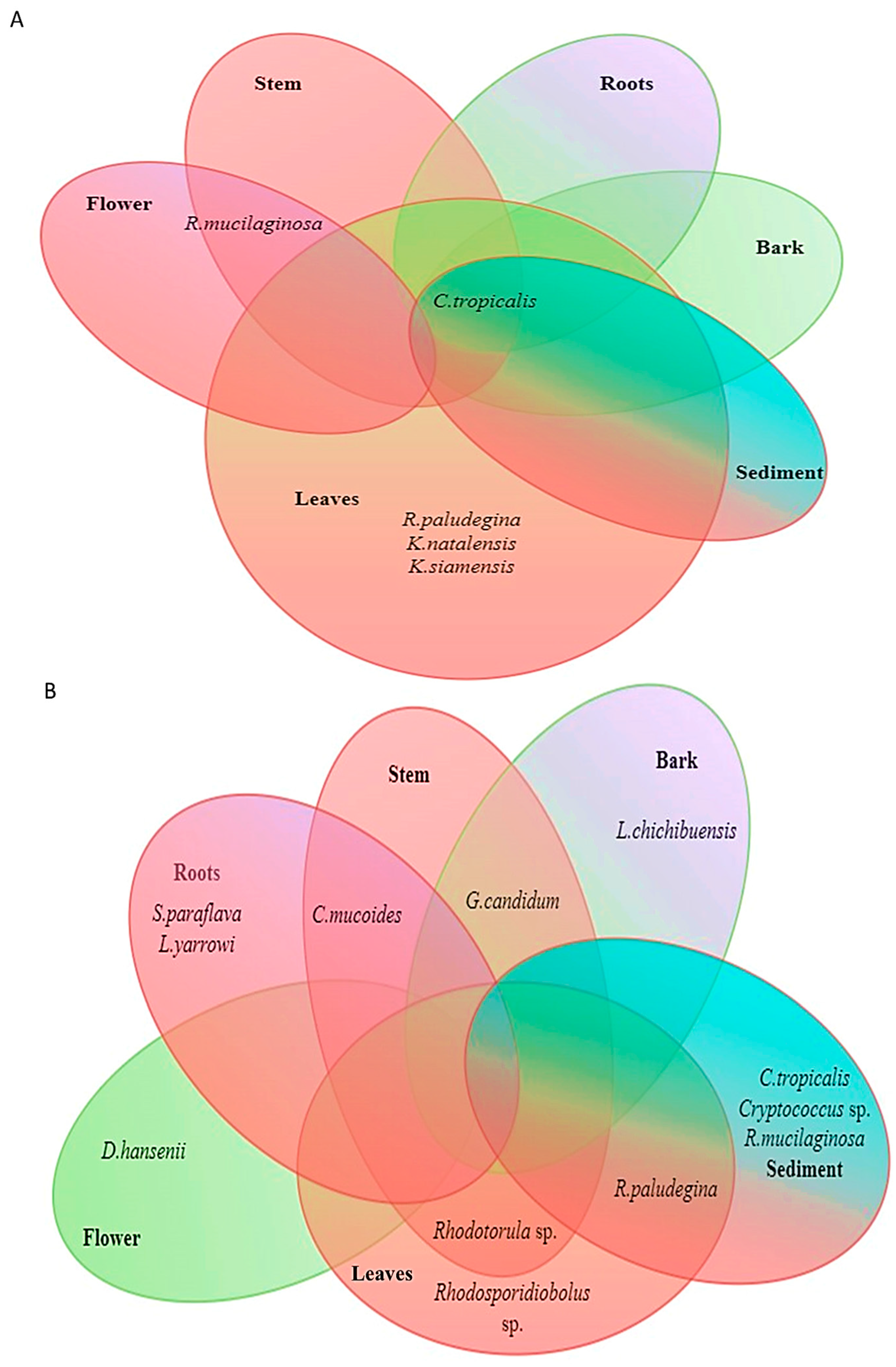Yeast Microbiome of Avicennia officinalis: Differences in Its Taxonomic and Functional Composition Within Plant Compartments †
Abstract
1. Introduction
2. Materials and Methods
2.1. Yeast Species Used for Study
2.2. Sample Preparation
2.2.1. Elemental Composition of Plant Parts
2.2.2. Determination of Sodium, Potassium, and Calcium
2.3. Statistical Analysis
3. Results and Discussion
3.1. Diversity of Yeast Associated with A. officinalis
3.2. Variability of Plant Elemental Composition Among Mangrove Plant Compartments
4. Conclusions
Author Contributions
Funding
Institutional Review Board Statement
Informed Consent Statement
Data Availability Statement
Acknowledgments
Conflicts of Interest
References
- Dastogeer, K.M.; Tumpa, F.H.; Sultana, A.; Akter, M.A.; Chakraborty, A. Plant microbiome—An account of the factors that shape community composition and diversity. Curr. Plant Biol. 2020, 23, 100161. [Google Scholar] [CrossRef]
- Compant, S.; Samad, A.; Faist, H.; Sessitsch, A. A review on the plant microbiome: Ecology, functions, and emerging trends in microbial application. J. Adv. Res. 2019, 19, 29–37. [Google Scholar] [CrossRef] [PubMed]
- Vorholt, J.A. Microbial life in the phyllosphere. Nat. Rev. Microbiol. 2012, 10, 828–840. [Google Scholar] [CrossRef] [PubMed]
- Purahong, W.; Kapturska, D.; Pecyna, M.J.; Jariyavidyanont, K.; Kaunzner, J.; Juncheed, K.; Uengwetwanit, T.; Rudloff, R.; Schulz, E.; Hofrichter, M.; et al. Effects of forest management practices in temperate beech forests on bacterial and fungal communities involved in leaf litter degradation. Microb. Ecol. 2015, 69, 905–913. [Google Scholar] [CrossRef] [PubMed]
- Coleman-Derr, D.; Desgarennes, D.; Fonseca-Garcia, C.; Gross, S.; Clingenpeel, S.; Woyke, T.; North, G.; Visel, A.; Partida-Martinez, L.P.; Tringe, S.G. Plant compartment and biogeography affect microbiome composition in cultivated and native Agave species. New Phytol. 2016, 209, 798–811. [Google Scholar] [CrossRef] [PubMed]
- Cregger, M.A.; Veach, A.M.; Yang, Z.K.; Crouch, M.J.; Vilgalys, R.; Tuskan, G.A.; Schadt, C.W. The Populus holobiont: Dissecting the effects of plant niches and genotype on the microbiome. Microbiome 2018, 6, 31. [Google Scholar] [CrossRef] [PubMed]
- Jiao, S.; Peng, Z.; Qi, J.; Gao, J.; Wei, G. Linking bacterial-fungal relationships to microbial diversity and soil nutrient cycling. mSystems 2021, 6, 10-1128. [Google Scholar] [CrossRef] [PubMed]
- Nimsi, K.A.; Manjusha, K.; Hatha, A.A.M.; Kathiresan, K. Diversity, distribution, and bioprospecting potentials of manglicolous yeasts: A review. FEMS Microbiol. Ecol. 2023, 99, fiad044. [Google Scholar] [CrossRef] [PubMed]
- Thatoi, H.; Behera, B.C.; Mishra, R.R.; Dutta, S.K. Biodiversity and biotechnological potential of microorganisms from mangrove ecosystems: A review. Ann. Microbiol. 2012, 63, 1–19. [Google Scholar] [CrossRef]
- Lee, G.; Lee, S.H.; Kim, K.M.; Ryu, C.M. Foliar application of the leaf-colonizing yeast Pseudozymachurashimaensis elicits systemic defense of pepper against bacterial and viral pathogens. Sci. Rep. 2017, 7, 39432. [Google Scholar]
- SlÁviková, E.; Vadkertiová, R.; Vránová, D. Yeasts colonizing the leaves of fruit trees. Ann. Microbiol. 2009, 59, 419–424. [Google Scholar] [CrossRef]
- Bordet, F.; Joran, A.; Klein, G.; Roullier-Gall, C.; Alexandre, H. Yeast–yeast interactions: Mechanisms, methodologies and impact on composition. Microorganisms 2020, 8, 600. [Google Scholar] [CrossRef] [PubMed]
- Nimsi, K.A.; Manjusha, K.; Krupesh, C.K. Diversity and hydrolytic potentials of manglicolous yeasts associated with mangrove trees Rhizophora and Avicennia found in Kerala, India. J. Aquat. Biol. Fish. 2023, 11 (Suppl. S1), 1–7. [Google Scholar]
- Clarke, K.; Gorley, R. User Manual/Tutorial, Primer Version 5; Primer-E: Plymouth, UK, 2001. [Google Scholar]
- Pallapati, A.R.; Sirigiri, S.D.; Jain, S.; Ratnala, V.; Roy, I. Lysine245 plays a crucial role in stability and function of glycerol 3-phosphate dehydrogenase (Gpd1) in Saccharomyces cerevisiae. J. Cell. Biochem. 2021, 122, 1726–1736. [Google Scholar] [CrossRef] [PubMed]
- Pallapati, A.R.; Prasad, S.; Roy, I. Glycerol 3-phosphate dehydrogenase regulates heat shock response in Saccharomyces cerevisiae. Biochim. Et Biophys. Acta. Mol. Cell Res. 2022, 1869, 119238. [Google Scholar] [CrossRef] [PubMed]




| Shannon–Wiener Diversity Index (H′ (log2) | ||
|---|---|---|
| Kumbalam | Puthuvype | |
| Leaf | 2 | 1.46 |
| Root | 0 | 1.59 |
| Stem | 0.92 | 1.5 |
| Bark | 0 | 1 |
| Flower | 0 | 0 |
| Sediment | 0 | 1.84 |
Disclaimer/Publisher’s Note: The statements, opinions and data contained in all publications are solely those of the individual author(s) and contributor(s) and not of MDPI and/or the editor(s). MDPI and/or the editor(s) disclaim responsibility for any injury to people or property resulting from any ideas, methods, instructions or products referred to in the content. |
© 2025 by the authors. Licensee MDPI, Basel, Switzerland. This article is an open access article distributed under the terms and conditions of the Creative Commons Attribution (CC BY) license (https://creativecommons.org/licenses/by/4.0/).
Share and Cite
Nimsi, K.A.S.; Manjusha, K.; Vijayan, J. Yeast Microbiome of Avicennia officinalis: Differences in Its Taxonomic and Functional Composition Within Plant Compartments. Biol. Life Sci. Forum 2024, 39, 7. https://doi.org/10.3390/blsf2024039007
Nimsi KAS, Manjusha K, Vijayan J. Yeast Microbiome of Avicennia officinalis: Differences in Its Taxonomic and Functional Composition Within Plant Compartments. Biology and Life Sciences Forum. 2024; 39(1):7. https://doi.org/10.3390/blsf2024039007
Chicago/Turabian StyleNimsi, Kizhakkeyveetil Abdul Saleem, Kozhikotte Manjusha, and Jasna Vijayan. 2024. "Yeast Microbiome of Avicennia officinalis: Differences in Its Taxonomic and Functional Composition Within Plant Compartments" Biology and Life Sciences Forum 39, no. 1: 7. https://doi.org/10.3390/blsf2024039007
APA StyleNimsi, K. A. S., Manjusha, K., & Vijayan, J. (2024). Yeast Microbiome of Avicennia officinalis: Differences in Its Taxonomic and Functional Composition Within Plant Compartments. Biology and Life Sciences Forum, 39(1), 7. https://doi.org/10.3390/blsf2024039007







